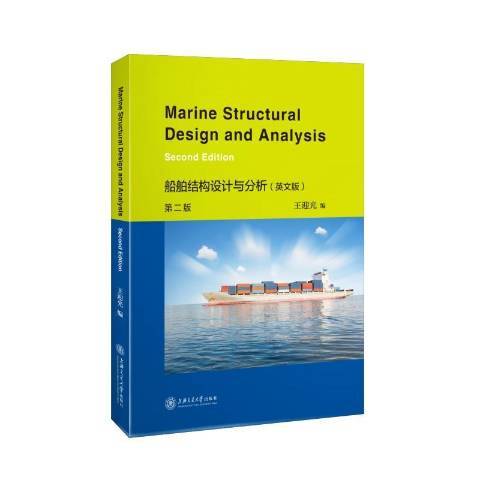內容簡介
本書概述了現代船舶結構設計的基本理論和方法,並提供了若干設計實例。全書共分6章。第1章介紹了船舶結構設計方法,闡述了基於半經驗船級社規範的傳統設計方法和基於*原理的現代設計方法。第2章介紹了一些船舶結構設計的基本要素,包括: 結構布置、結構材料、焊接和一些船級社及其規範的基本知識。第3章和第4章考慮船舶結構設計過程中的載荷和載荷組合以及如何計算一特定船舶結構的初始構件尺寸。第5章對一初步設計好了的船舶結構進行全強度評估,這一章敘述了屈服、屈曲和疲勞衡準,本章也給出了對船舶結構譜疲勞分析的詳盡解釋。*後,第6章提供了船舶結構設計最佳化的基本知識(連續最佳化和離散最佳化、約束最佳化和非約束最佳化、全局最佳化和局部最佳化等),並提供了具體的計算實例。
圖書目錄
Chapter 1Introduction to marine structural design1
1.1The traditional design method 1
1.1.1The evolutionary process1
1.1.2A ship structural design example 1
1.1.3The changes to the traditional design method 5
1.2The modern design method6
1.2.1The first principles based approach 6
1.2.2The design procedure 7
1.2.3Benefits of the modern approach 10
Chapter 2Marine structural design fundamentals 12
2.1Structural arrangement design 12
2.1.1Subdivision arrangement 12
2.1.2Compartment arrangement14
2.1.3Access arrangement14
2.2Structural materials 16
2.2.1Introduction to materials 16
2.2.2Standard steels used for hull and other structure 18
2.2.3High strength steel used for hull and other structures
20
2.2.4Selection for steel grades 22
2.2.5Other ship materials 24
2.2.6An example of ship materials used for a dredging barge
26
2.3Welding 27
2.3.1The base types of welding joints 28
2.3.2The base types of welding line 30
2.3.3Stud welding 30
2.3.4The determination of the weld size32
2.3.5A welding design example 37
2.4Classification societies and their rules 39
2.4.1Classification societies 39
2.4.2Class rules, regulations and guides44
Chapter 3Loads and loads combinations 52
3.1Environmental considerations 52
3.2Loads52
3.2.1Static loads 53
3.2.2The wave induced loads 54
3.2.3The hydrodynamic loads 57
3.2.4The sloshing loads 58
3.2.5The impact loads59
3.2.6Other loads types59
3.3Loads combinations60
3.4Strength modeling and development of strength criteria 61
Chapter 4Marine structural initial design 64
4.1Hull girder strength and shearing strength 64
4.2Hull structural members design 67
4.2.1Plating design67
4.2.2Longitudinals and girders design 70
4.2.3Bulkhead design73
4.3An example of hull structural members designpillar design 76
4.3.1Basic design of pillars 76
4.3.2Some requirements for the pillars in rules 88
4.3.3Regulations of pillars on different types of ships 97
4.4Superstructure design98
4.4.1The interaction between the superstructure and the
main hull 98
4.4.2The design of superstructures 103
4.4.3The failure of superstructures and prevention measures
109
4.5Introduction to structures of various kinds of ships 111
4.5.1Oil tankers 111
4.5.2Bulk carriers 123
4.5.3Container ships 146
Chapter 5Marine structural design analysis 156
5.1Total strength assessment 156
5.1.1Yielding strength 156
5.1.2Buckling and ultimate strength 156
5.1.3Fatigue strength 157
5.2Strength criteria158
5.2.1General introduction 158
5.2.2Yielding criteria 159
5.2.3Buckling and ultimate strength criteria 161
5.2.4Fatigue criteria164
5.3Finite element analysis166
5.3.1The developmental history of the finite element
analysis 166
5.3.2The basic idea of the finite element method 167
5.3.3A finite element analysis example — a 75,000 DWT
bulk carrier 170
5.4Spectral fatigue analysis of ship structures 178
5.5The transverse strength analysis of a ship 193
5.5.1Setting the design load194
5.5.2Simplification of members geometry size194
5.5.3Simplification of the frame supporting conditions
195
5.5.4Modeling the structure processing 196
5.5.5Modeling the loads 196
5.5.6Building the finite element model for the ship
structures197
Chapter 6Marine structural design optimization198
6.1The introduction to the optimization 198
6.2The categorization methods for optimization problems 199
6.2.1Continuous versus discrete optimization 199
6.2.2Constrained and unconstrained optimization200
6.2.3Global and local optimization 201
6.2.4Deterministic and stochastic optimization 201
6.3An example — the optimization of stiffened panels 202
6.3.1Introduction to stiffened plates 202
6.3.2The numerical solution method for a stiffened panel 203
6.3.3Summarization 224
6.4Another example — the optimization of a T -bar 225
6.4.1The problem raised and the model established 225
6.4.2Analytical solution method 228
6.4.3Finite element analysis solution method 230
6.4.4Comments on each solution method 233
References 234
作者簡介
王迎光:上海交通大學碩士導師,長期從事海洋工程隨機結構動力學; 船舶非線性動力學; 船舶結構最佳化設計研究。

